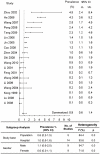HIV/TB co-infection in mainland China: a meta-analysis
- PMID: 20505769
- PMCID: PMC2873981
- DOI: 10.1371/journal.pone.0010736
HIV/TB co-infection in mainland China: a meta-analysis
Abstract
Background: TB and HIV co-epidemic is a major public health problem in many parts of the world, particularly in developing counties. We aimed to summarize the prevalence of TB and HIV co-infection in mainland China, using meta-analysis based on systematic review of published articles.
Methods: We systematically reviewed published studies, from the MEDLINE and Chinese BioMedical Literature Databases, on the prevalence of HIV infection among TB patients and on the prevalence of TB among HIV/AIDS population until 15 April 2010, and quantitatively summarized the estimates using meta-analysis.
Results: In total, 29 studies were included in this review, with consistently homogeneous results. TB patients, for whom the summary prevalence of HIV infection was 0.9% (0.6%-1.4%) in mainland China, were found to be a potential target population for HIV screening. The prevalence of TB among HIV/AIDS population was 7.2% (4.2%-12.3%), but this was much higher when the analyses were restricted to AIDS patients (22.8%). Significantly higher prevalence was observed for males and hospital-based studies.
Conclusions: Our analyses indicated that the prevalence of HIV/TB co-infection in China deserves special attention, screening of TB among HIV/AIDS populations should be attached more importance, which would be much more helpful for treatment of both diseases.
Conflict of interest statement
Figures
Similar articles
-
Prevalence of tuberculosis, HIV, and TB-HIV co-infection among pulmonary tuberculosis suspects in a predominantly pastoralist area, northeast Ethiopia.Glob Health Action. 2015 Dec 18;8:27949. doi: 10.3402/gha.v8.27949. eCollection 2015. Glob Health Action. 2015. PMID: 26689454 Free PMC article.
-
Clinical correlate of tuberculosis in HIV co-infected children at the University of Abuja Teaching Hospital, Gwagwalada, Nigeria.Niger J Clin Pract. 2011 Apr-Jun;14(2):206-11. doi: 10.4103/1119-3077.84018. Niger J Clin Pract. 2011. PMID: 21860141
-
Prevalence of TB/ HIV co-infection in Iran: a systematic review and meta-analysis.Ann Ig. 2019 Jul-Aug;31(4):333-348. doi: 10.7416/ai.2019.2295. Ann Ig. 2019. PMID: 31268118
-
Clinical features of tuberculosis associated with HIV infection in Taiwan.J Formos Med Assoc. 1996 Dec;95(12):923-8. J Formos Med Assoc. 1996. PMID: 9000809
-
Meta-analysis: prevalence of HIV infection and syphilis among MSM in China.Sex Transm Infect. 2009 Sep;85(5):354-8. doi: 10.1136/sti.2008.034702. Epub 2009 Apr 6. Sex Transm Infect. 2009. PMID: 19351623 Review.
Cited by
-
Risk Factors for the Development of Tuberculosis Among HIV-Positive Adults Under Highly Active Antiretroviral Therapy at Government Hospitals in Amhara Region, Ethiopia.Int J Gen Med. 2022 Mar 15;15:3031-3041. doi: 10.2147/IJGM.S358517. eCollection 2022. Int J Gen Med. 2022. PMID: 35313549 Free PMC article.
-
Tuberculosis/HIV Coinfection and Treatment Trends - China, 2015-2019.China CDC Wkly. 2020 Nov 27;2(48):924-928. doi: 10.46234/ccdcw2020.252. China CDC Wkly. 2020. PMID: 34594802 Free PMC article. No abstract available.
-
Epidemiology of tuberculosis in Chongqing, China: a secular trend from 1992 to 2015.Sci Rep. 2017 Aug 10;7(1):7832. doi: 10.1038/s41598-017-07959-2. Sci Rep. 2017. PMID: 28798367 Free PMC article.
-
Coinfection of hepatitis B, tuberculosis, and HIV/AIDS in Beijing from 2016 to 2023: a surveillance data analysis.BMC Infect Dis. 2025 Apr 23;25(1):584. doi: 10.1186/s12879-025-10952-0. BMC Infect Dis. 2025. PMID: 40269753 Free PMC article.
-
Diagnostic values of Xpert MTB/RIF, T-SPOT.TB and adenosine deaminase for HIV-negative tuberculous pericarditis in a high burden setting: a prospective observational study.Sci Rep. 2020 Oct 1;10(1):16325. doi: 10.1038/s41598-020-73220-y. Sci Rep. 2020. PMID: 33004934 Free PMC article.
References
-
- Harrington M. From HIV to Tuberculosis and Back Again: A Tale of Activism in 2 Pandemics. Clin Infect Dis. 2010;50:S260–266. - PubMed
-
- Friedland G, Churchyard GJ, Nardell E. Tuberculosis and HIV coinfection: current state of knowledge and research priorities. J Infect Dis. 2007;196(Suppl 1):S1–3. - PubMed
-
- Corbett EL, Watt CJ, Walker N, Maher D, Williams BG, et al. The growing burden of tuberculosis: global trends and interactions with the HIV epidemic. Arch Intern Med. 2003;163:1009–1021. - PubMed
-
- Meya DB, McAdam KP. The TB pandemic: an old problem seeking new solutions. J Intern Med. 2007;261:309–329. - PubMed
-
- Girardi E, Raviglione MC, Antonucci G, Godfrey-Faussett P, Ippolito G. Impact of the HIV epidemic on the spread of other diseases: the case of tuberculosis. AIDS. 2000;14(Suppl 3):S47–56. - PubMed
Publication types
MeSH terms
LinkOut - more resources
Full Text Sources
Medical
Miscellaneous




